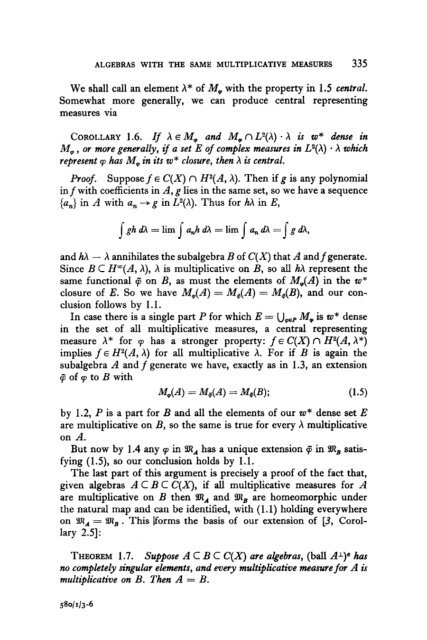On the Characters and the Plancherel Formula of Nilpotent Groups ...
On the Characters and the Plancherel Formula of Nilpotent Groups ...
On the Characters and the Plancherel Formula of Nilpotent Groups ...
You also want an ePaper? Increase the reach of your titles
YUMPU automatically turns print PDFs into web optimized ePapers that Google loves.
ALGEBRAS WITH THE SAME MULTIPLICATIVE MEASURES 335<br />
We shall call an element A* <strong>of</strong> M, with <strong>the</strong> property in 1.5 central.<br />
Somewhat more generally, we can produce central representing<br />
measures via<br />
COROLLARY 1.6. If h E M, <strong>and</strong> M, n L2(h) * h is w* dense in<br />
M, , or more generally, if a set E <strong>of</strong> complex measures in L2(h) * A which<br />
represent q~ has M, in its w* closure, <strong>the</strong>n h is central.<br />
Pro<strong>of</strong>. Suppose f E C(X) n H2(A, A). Then if g is any polynomial<br />
in f with coefficients in A, g lies in <strong>the</strong> same set, so we have a sequence<br />
{un} in A with a, -+ g in L2(X). Thus for hh in E,<br />
<strong>and</strong> hh - h annihilates <strong>the</strong> subalgebra B <strong>of</strong> C(X) that A <strong>and</strong> f generate.<br />
Since B C H”(A, h), h is multiplicative on B, so all hX represent <strong>the</strong><br />
same functional rj? on B, as must <strong>the</strong> elements <strong>of</strong> M,(A) in <strong>the</strong> w*<br />
closure <strong>of</strong> E. So we have M,(A) = M,(A) = M,(B), <strong>and</strong> our con-<br />
clusion follows by 1 .l.<br />
In case <strong>the</strong>re is a single part P for which E = uWp M, is w* dense<br />
in <strong>the</strong> set <strong>of</strong> all multiplicative measures, a central representing<br />
measure A* for v has a stronger property: f E C(X) n H2(A, A*)<br />
implies f E H2(A, A) f or all multiplicative A. For if B is again <strong>the</strong><br />
subalgebra A <strong>and</strong> f generate we have, exactly as in 1.3, an extension<br />
4 <strong>of</strong> y to B with<br />
M,(A) = M,(A) = M,(B); (1.5)<br />
by 1.2, P is a part for B <strong>and</strong> all <strong>the</strong> elements <strong>of</strong> our w* dense set E<br />
are multiplicative on B, so <strong>the</strong> same is true for every h multiplicative<br />
on A.<br />
But now by 1.4 any q in m, has a unique extension rjj in ‘9XB satisfying<br />
(1.5), so our conclusion holds by 1.1.<br />
The last part <strong>of</strong> this argument is precisely a pro<strong>of</strong> <strong>of</strong> <strong>the</strong> fact that,<br />
given algebras A C B C C(x), if all multiplicative measures for A<br />
are multiplicative on B <strong>the</strong>n %RA <strong>and</strong> !LRB are homeomorphic under<br />
<strong>the</strong> natural map <strong>and</strong> can be identified, with (1.1) holding everywhere<br />
on %RA = !LRB. This lforms <strong>the</strong> basis <strong>of</strong> our extension <strong>of</strong> [3, Corollary<br />
2.51:<br />
THEOREM 1.7. Suppose A C B C C(X) are a&ebras, (ball AI)e has<br />
no completely singular elements, <strong>and</strong> every multiplicative measure for A is<br />
multiplicative on B. Then A = B.

















